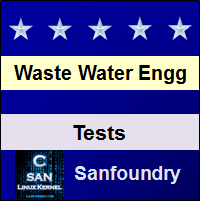 Our Waste Water Engineering Tests allow you to experience an online examination in the real-time environment. In every online test on Waste Water Engineering, you will be presented with Multiple Choice Questions (MCQs) which will test your skills in Waste Water Engineering Concepts in a detailed and comprehensive manner. In the test, each question will have 4 options to choose from. You should select only 1 correct option as an answer and then move on to the next question. Once you submit answers to all the questions, you will be given your final test score.
Our Waste Water Engineering Tests allow you to experience an online examination in the real-time environment. In every online test on Waste Water Engineering, you will be presented with Multiple Choice Questions (MCQs) which will test your skills in Waste Water Engineering Concepts in a detailed and comprehensive manner. In the test, each question will have 4 options to choose from. You should select only 1 correct option as an answer and then move on to the next question. Once you submit answers to all the questions, you will be given your final test score.In the Online Waste Water Engineering Test, for every correct answer, you will be given 2 points. There will also be negative marking of -1 for every wrong answer. So, you will have to be more careful in choosing the answers to the question in your online examination. If needed, you should skip to the next question and come back to the previous question later so that you can do proper time management for the online mock tests.
Based on your score, you would be given one of the following Grades:
Grade A* - Genius (You scored 100%)
Grade A - Excellent (Your score is in the range of 80% to 99%)
Grade B - Good (Your score is in the range of 60% to 80%)
Grade C - Average (Your score is in the range of 40% to 60%)
Grade D - Poor (Your score is in the range of 0% to 40%)
There will be 5 types of Waste Water Engineering Tests. The details of each of these tests are as follows:
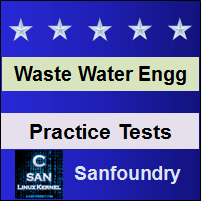 1. "Waste Water Engineering Practice Tests 1-10" - In Waste Water Engineering practice tests, there will be a series of practice tests wherein you can test your Waste Water Engineering concepts on every chapter separately. There are totally 10 different chapters on this subject and hence there will be 10 different practice tests wherein each practice tests covers one chapter exclusively. There will not be any time limit on these tests. So, Waste Water Engineering Practice Tests should be the first set of tests which you should attempt. Goto these practice tests here.
1. "Waste Water Engineering Practice Tests 1-10" - In Waste Water Engineering practice tests, there will be a series of practice tests wherein you can test your Waste Water Engineering concepts on every chapter separately. There are totally 10 different chapters on this subject and hence there will be 10 different practice tests wherein each practice tests covers one chapter exclusively. There will not be any time limit on these tests. So, Waste Water Engineering Practice Tests should be the first set of tests which you should attempt. Goto these practice tests here.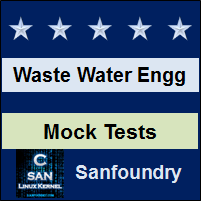 2. "Waste Water Engineering Mock Tests 1-10" - In Waste Water Engineering mock tests, there will be a series of mock tests wherein you can test your Waste Water Engineering concepts on every chapter separately, but there will be a fixed time limit per mock test. Here also, there are 10 mock tests wherein each mock test covers only one chapter exclusively. So, it is similar to Waste Water Engineering Practice Tests, but with an added constraint of time limits. You should try Waste Water Engineering Mock Tests if you are appearing for any online examination soon. Goto these mock tests here.
2. "Waste Water Engineering Mock Tests 1-10" - In Waste Water Engineering mock tests, there will be a series of mock tests wherein you can test your Waste Water Engineering concepts on every chapter separately, but there will be a fixed time limit per mock test. Here also, there are 10 mock tests wherein each mock test covers only one chapter exclusively. So, it is similar to Waste Water Engineering Practice Tests, but with an added constraint of time limits. You should try Waste Water Engineering Mock Tests if you are appearing for any online examination soon. Goto these mock tests here.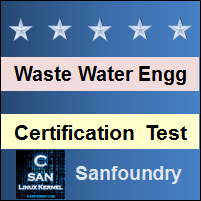 3. "Waste Water Engineering Certification Test" - Once you are thorough with your Waste Water Engineering concepts, then you can try our Waste Water Engineering Certification Test wherein your name will be mentioned in Top Rankers list, if you scored either Grade A* or Grade A in the Waste Water Engineering Certification Test. The Certification Test is free. Goto Waste Water Engineering Certification test here.
3. "Waste Water Engineering Certification Test" - Once you are thorough with your Waste Water Engineering concepts, then you can try our Waste Water Engineering Certification Test wherein your name will be mentioned in Top Rankers list, if you scored either Grade A* or Grade A in the Waste Water Engineering Certification Test. The Certification Test is free. Goto Waste Water Engineering Certification test here.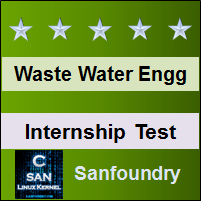 4. "Waste Water Engineering Internship Test" - If you are interested to do Internships in Waste Water Engineering at Sanfoundry, then you must take our Waste Water Engineering Internship Test. If you scored either Grade A* or Grade A in Waste Water Engineering Internship Test, then you are eligible for Internship at Sanfoundry in Waste Water Engineering. Goto Waste Water Engineering Internship test here.
4. "Waste Water Engineering Internship Test" - If you are interested to do Internships in Waste Water Engineering at Sanfoundry, then you must take our Waste Water Engineering Internship Test. If you scored either Grade A* or Grade A in Waste Water Engineering Internship Test, then you are eligible for Internship at Sanfoundry in Waste Water Engineering. Goto Waste Water Engineering Internship test here.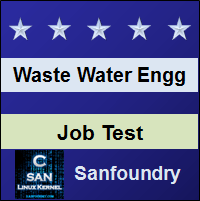 5. "Waste Water Engineering Job Test" - If you are a fresher, a dropout, an experienced person and if you know Waste Water Engineering well and looking out for jobs in Waste Water Engineering domain at Sanfoundry (or our Network of Companies), then you should try and qualify our "Waste Water Engineering Job Test". If you scored either Grade A* or Grade A in Waste Water Engineering Job Test, then you are eligible for a Job at Sanfoundry (or our Network) in Waste Water Engineering domain. Kindly note that you can repeat this job test after a gap of 30 days from the day of last attempt of the test. Goto Waste Water Engineering Job test here.
5. "Waste Water Engineering Job Test" - If you are a fresher, a dropout, an experienced person and if you know Waste Water Engineering well and looking out for jobs in Waste Water Engineering domain at Sanfoundry (or our Network of Companies), then you should try and qualify our "Waste Water Engineering Job Test". If you scored either Grade A* or Grade A in Waste Water Engineering Job Test, then you are eligible for a Job at Sanfoundry (or our Network) in Waste Water Engineering domain. Kindly note that you can repeat this job test after a gap of 30 days from the day of last attempt of the test. Goto Waste Water Engineering Job test here.For every "Waste Water Engineering Practice Test", Total Questions: 20, Total Time: Unlimited.
For every "Waste Water Engineering Mock Test", Total Questions: 20, Total Time: 20 Minutes.
For "Waste Water Engineering Certification Test", Total Questions: 50, Total Time: 1 hour.
For "Waste Water Engineering Internship Test", Total Questions: 50, Total Time: 1 hour.
For "Waste Water Engineering Job Test", Total Questions: 50, Total Time: 1 hour.
Before you get started on these series of online tests on Waste Water Engineering, you should learn, study and practice our collection of 1000 MCQs (Multiple Choice Questions and Answers) on Waste Water Engineering here. We also prefer that you should practice Waste Water Engineering practice tests and mock tests completely before attempting the certification test.
Here is the list of online practice tests and mock tests on Waste Water Engineering. Each online test focuses on a "Specific chapter of Waste Water Engineering". So, you should try both practice test and mock test on every chapter to do a self-assessment of your knowledge (along with time-limit constraints) in every area or sub-topic of Waste Water Engineering. Waste Water Engineering Certification test, Internship test, and Job Test are mentioned at the end of this list.
1. Waste Water Engineering Test 1 – This set of online test on “Waste Water Engineering” tests your skills on Systems of Waste and Sewage Disposal, Classification of Water Carriage System, Dry Weather Flow & Variations in Rate of Sewage, Minimum and Maximum Velocity of Flow, Sewer Sections, Construction & Planning of Sewer System, Sewer Appurtenances, Pumps & Pumping Stations – 1, Pumps & Pumping Stations – 2, Different Types of Valves, Autoclaves, Blowers.
2. Waste Water Engineering Test 2 – This set of online test on “Waste Water Engineering” tests your skills on Characteristics of Wastewater – 1, Characteristics of Wastewater – 2, Determination of Chemical Characteristics, Chemical Reactions Associated with Water Treatment, Correlation of Mass Transfer with Water Treatment, Dilution & Oxygen Sag Analysis, Self Purification of Natural Streams, Disposal by Land Treatment, Unit Operations and Unit Processes, Different Types of Reactors in Water Treatment – 1, Different Types of Reactors in Water Treatment – 2.
3. Waste Water Engineering Test 3 – This set of online test on “Waste Water Engineering” tests your skills on Methods for Treatment of Wastewater – 1, Methods for Treatment of Wastewater – 2, Methods of Sludge Processing and Disposal – 1, Methods of Sludge Processing and Disposal – 2, Screens and Comminutors – 1, Screens and Comminutors – 2, Aerated Grit Chambers, Settling of Discrete Particles, Types of Settling Tank, Sedimentation Tanks – 1, Sedimentation Tanks – 2, Chemical Clarification – 1.
4. Waste Water Engineering Test 4 – This set of online test on “Waste Water Engineering” tests your skills on Chemical Clarification – 2, Flocculant Settling, Sewage Filters, Sand Filters – 1, Sand Filters – 2, Trickling Filters – 1, Trickling Filters – 2, High Rate Filtration, Secondary Clarifiers – 1, Secondary Clarifiers – 2.
5. Waste Water Engineering Test 5 – This set of online test on “Waste Water Engineering” tests your skills on Tube Settlers, Activated Sludge Process – 1, Activated Sludge Process – 2, Diffused and Mechanical Aeration Systems, Sludge Production and Process Control, Activated Sludge Treatment Systems – 1, Activated Sludge Treatment Systems – 2, Secondary Settling, Oxidation Ditch, Aerobic Ponds, Facultative Ponds, Sequential Batch Reactor & BOD Removal Methods, Moving Bed Bioreactor.
6. Waste Water Engineering Test 6 – This set of online test on “Waste Water Engineering” tests your skills on Moving Bed Reactor, Sludge Treatment Process – 1, Sludge Treatment Process – 2, Sludge Characteristics, Thickening and Concentration – 1, Sludge Characteristics, Thickening and Concentration – 2, Anaerobic Digestion, Septic Tanks, Effluent Disposal in Septic Tanks, Oil and Grease Removal Methods, Lamella Clarifiers and Oil Removal belt, Suspended Solids Removal & Dissolved Air Floatation – 1.
7. Waste Water Engineering Test 7 – This set of online test on “Waste Water Engineering” tests your skills on Suspended Solids Removal & Dissolved Air Floatation – 2, Ultrafiltration, Rapid Filtration, Disc Filtration – 1, Disc Filtration – 2, Adsorption and Water Treatment, Adsorption by Activated Carbon, Phosphorus Removal – 1, Phosphorus Removal – 2, Nitrogen Removal, Biological Nitrification and Denitrification, Ammonia Stripping.
8. Waste Water Engineering Test 8 – This set of online test on “Waste Water Engineering” tests your skills on Wet Air Oxidation & Electrocoagulation, UASB Reactor – 1, UASB Reactor – 2, Total Dissolved Solids – 1, Total Dissolved Solids – 2, Reverse Osmosis, Reverse Osmosis Design, Reverse Osmosis Membrane Properties – 1, Reverse Osmosis Membrane Properties – 2, Fouling and Scaling of Membranes, Ion Exchange Process.
9. Waste Water Engineering Test 9 – This set of online test on “Waste Water Engineering” tests your skills on Ion Exchange Media Properties – 1, Ion Exchange Media Properties – 2, Ion Exchange Design, Softners, Removal of Iron, Manganese and Arsenic – 1, Removal of Iron, Manganese and Arsenic – 2, Disinfection Process – 1, Disinfection Process – 2, Chlorinators, Advanced Oxidation Process – Ozonators, Advanced Oxidation Process-H2O2/UV, Characteristics of Industrial Wastewater.
10. Waste Water Engineering Test 10 – This set of online test on “Waste Water Engineering” tests your skills on Principles of House Drainage, Pipes and Traps, Sanitary Fittings, Systems of Plumbing, House Drainage Plans, Hydrogen Sulphide in Sewers, Storm Water Flow, Rural Sanitation, Collection and Disposal of Dry Refuse, Disposal of Excretal Wastes, Eco-Friendly Toilets, Corrosion Control in Water Conduits, Instrumentation used in a Water Treatment Plant.
Sanfoundry will issue a Certificate of Merit to Top 5 Rankers for a given month provided that they have scored either A* or A Grade in the Contest. If you are interested, then kindly register below. After registration, you can take the test anytime (24x7).
